Possible First Detection of Elusive Gravitational Waves Explained
April 17, 2014
The detection of gravitational waves in March 2014 sparked a flurry of interest in the physics community, but what does it mean to detect a gravity wave? Why is it such a big deal? To answer these questions, we’ll need to revisit the work of one of the the most prolific scientists of all time: Albert Einstein.
Relativity Foundations
We can thank Albert Einstein’s theory of general relativity for the idea of gravitational waves. But let’s start with special relativity.
Special relativity requires two important postulates – fundamental assumptions that the theory rests upon. One states that the laws of physics should have the same form in any reference frame moving with a constant velocity (an inertial frame). The other states that light travels at the speed c = 3×108 m/s in vacuum in all inertial reference frames, regardless of the speed of the light source or the observer.
The consequence of this is that if you turn on a flashlight in a parked space ship, and measure how fast the light travels, you will measure the speed c. If you turn on the flashlight in a spaceship moving at 0.99c (just under the speed of light) you will still measure that the light travels at the speed c.
Furthermore, a person standing in the spaceship parking garage will also measure that the light travels at a speed c for both situations. It doesn’t matter who is measuring the speed of the light or where that person measures from; everyone measures c when light travels in a vacuum.
Some results of these postulates leads to the following unintuitive results (even though they’re only noticeable at extremely high speeds):
- A moving clock runs more slowly than a stationary clock.
- A moving meter stick is shorter than a stationary meter stick.
- A moving object is more massive than a stationary object.
Here time and space are relative to the inertial frame and are no longer absolutes. Despite the speed required to observe these curious events, they have all been experimentally verified over and over again.
Unlike special relativity, general relativity deals with accelerated reference frames. In general relativity, space and time can be distorted by the presence of massive objects.
A common analogy depicts spacetime as a sheet of fabric, or a bed, and a heavy bowling ball depicts a massive object like a planet or star. You can visually observe the fabric being bent.
Upon closer inspection, you might see the woven strands pulled apart more in some sections and squashed together more in others. It is important to remember, however, that when a massive object does this, it is curving not only space but also time. Consequently, large gravitational fields affect how fast clocks run.
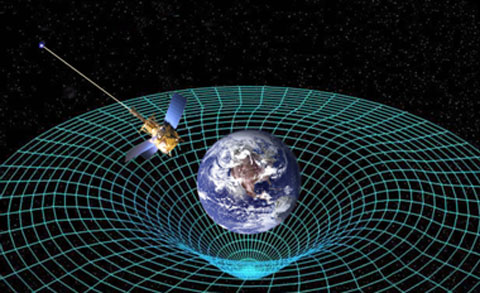
Artist’s rendering of space being curved by Earth.
Image credit: NASA via Wikimedia Commons
This is why all our GPS devices rely heavily on Einstein’s theories of special and general relativity.
Special relativity considerations slow the GPS satellite clocks down by about 7.2 millionths of a second per day. General relativity considerations speed the clocks up by about 45.9 millionths of a second per day. If this total 38.6 millionths of a second discrepancy were not taken into consideration, our GPS systems would be off by about 7.2 miles (11.6 km) in just one day!
Where Are The Gravitational Waves Lurking?
The fact that a massive object affects spacetime means that it can send a ripple through the fabric of spacetime. When a massive object moves, the curvature in spacetime is affected. Accelerated massive objects could generate a pulse or a wave that propagates through spacetime at the speed of light; these are gravitational waves.
But these waves are small and hard to detect unless the wave stems from an event between super-massive objects. For example, if two black holes collided they would produce a significant gravitational wave.
Another place scientists thought to look for the influence of gravitational waves was near pairs of neutron stars orbiting each other (a type of binary pulsar).
The strong influence of these two extremely massive stars orbiting each other causes the stars to spiral into each other, losing angular momentum and energy, and this would generate gravitational waves. The gravitational waves generated would carry away the binary’s ‘lost’ angular momentum and energy, maintaining the important conservation of energy and momentum laws.
The first binary pulsar was discovered in 1974 by Russel Hulse and Joseph Hooten Taylor. Pulsars are rapidly rotating stars that emit detectable radiation at regular time intervals. The rate at which the observed pulse varied in a regular way due to the Doppler effect.
The careful detection of these emissions also showed variations in time predicted by Einstein's general and special relativity. When the stars are at their closest approach, the gravitational field between them is at its strongest and time slows down. Special relativity affects time as well.
Furthermore, the prediction from general relativity of losing orbital momentum in the generation of a gravitational wave would affect the emission of the pulses in a particular way, tied to the change in the orbital motion of the stars.
The 1993 Nobel Prize in Physics was awarded to Hulse and Taylor for providing this evidence from four years of observations of a binary pulsar. Their measurements of the orbital decay and pulses provided strong evidence supporting Einstein’s theory of gravitational radiation. It was this evidence that led to the development of gravitational wave detectors to try to measure gravitational waves directly.
Searches for Direct Evidence
If a gravitational wave passes by, an observer would find measurements of space and time distorted by the wave. Space would be elongated in one direction and squashed in the other.
However, just as the light (electromagnetic waves) from a light bulb decreases in intensity the further you get from the light source, gravitational waves also decrease in intensity the further the measurements are made from their source.
This largely explains the difficulty in measuring gravitational waves as they pass by Earth. After traveling astronomical distances, their intensity and effects on spacetime are very small.
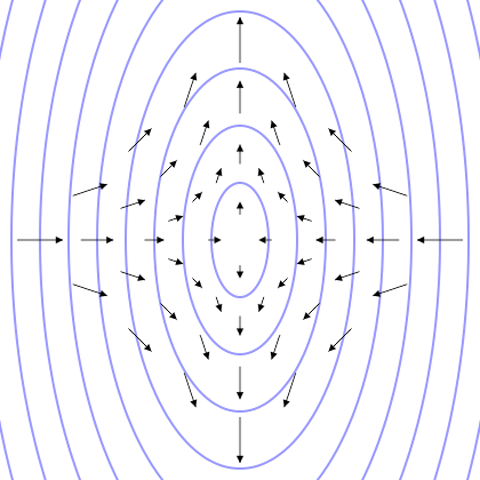
Animation of gravitational wave effecting particles in space.
Image credit: Raoul NK via Wikimedia Commons
Two observatories, LIGO (Laser Interferometer Gravitational Wave Observatory) and EGO (European Gravitational Observatory), which runs the VIRGO interferometer, are designed to measure gravitational waves directly.
Scientists expect that if a gravitational wave were to pass by, it would slightly elongate one direction of space and slightly squish another, both of these directions would be perpendicular to the direction the waves travel in. An example of an interferometer trying to detect these waves is shown below.
The passing wave would elongate one arm of the interferometer and shorten the other, causing the path length of the two laser beams to travel different distances. A strong wave may change their path length by a billionth of a billionth of a meter (10-18 m). When the path length of the two beams is altered the two beams interfere differently. The effect however would be very small.
To compensate for the very small effect of the gravitational wave, the arms of the three different interferometers used by LIGO are 2 to 4 km long and the laser beams are encased in a 1 m diameter vacuum tube that runs the entire length of the arms. By measuring slight changes in the interference pattern produced by these two very long laser beams, they would have direct evidence of a gravitational wave.
At this time, no gravitational wave observatory anywhere has measured gravitational waves directly. A space-based observatory for direct measurement is currently being developed.
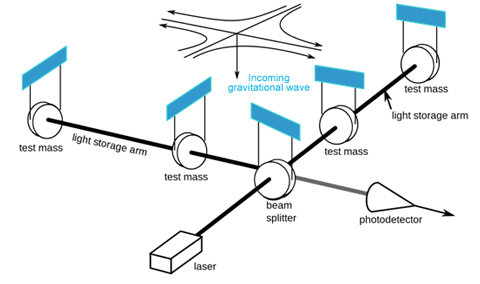
Diagram of a laser interferometer.
Image credit: Work by Malyszkz edited by MOBle via Wikimedia commons
Inflation, the Big Bang, and Gravitational Waves
Despite the lack of direct evidence from the aforementioned interferometers, astronomers have other means of detecting the effects of gravitational waves.
When the universe began with the big bang about 13.8 billion years ago, scientists theorize that it grew exponentially for about 10-35 (or 10-36) of a second during a period called inflation. The idea is that when the big bang occurred it only contained a quantum field.
During the extremely rapid expansion of inflation, the universe flattened and particles were formed from the quantum field. With energy being transformed into particles, the inflation stopped.
If this did indeed occur, then a large gravitational wave would have been created, called the primordial gravitational wave. This wave, like all gravitational waves, would compress space in one direction and expand it in another, both perpendicular to the direction the wave travels in. The primordial gravitational wave may still be propagating, but its amplitude would be too small to detect. Still, effects of such a wave should be detectable.
Note that when we measure the light from our closest neighboring star 4.3 light years away, we are seeing light that the star emitted 4.3 years ago. When we view stars 200 light years away, we are viewing light emitted 200 years ago. Likewise, when we look into our universe for gravitational waves, we can look for remnants emitted millions or billions of years ago.
It is also important to note that light travels along the space-time lines, and if those lines curve, then the light curves. The Cosmic Microwave Background (CMB) is the universe’s background microwave radiation and this background radiation would be effected by a gravitational wave, particularly the first gravitational wave of our universe.
In effect, the radiation would be polarized, meaning that the electric field component of the radiation would line up in a special pattern because of the passing of the gravitational wave. In general, you can think of polarization as a preferred direction of oscillation. For example, if you had a linear polarized wave it would oscillate in one dimension as shown.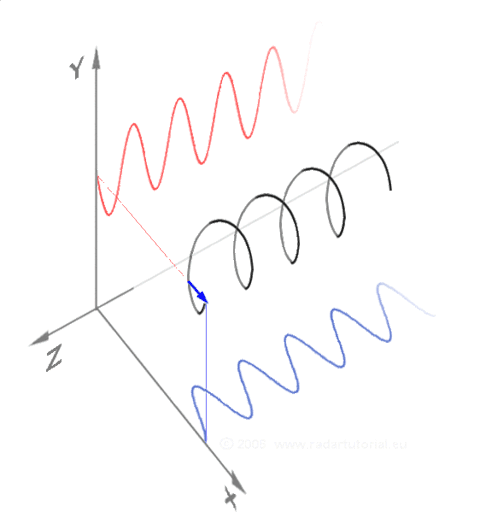
Animation of a linear polarized wave in the y direction (red), a linear polarized wave in the x direction (blue), and their sum, a circularly polarized wave (black).
Image credit: de:Benutzer:Averse via Wikimedia Commons
If gravitational waves were created during inflation, then as they passed through space, say perpendicular to the page (directly into or out of it), the microwave background’s electric field oscillations would become polarized (line up) in a special way, as shown in the diagram below. This is known as B-mode polarization.
B-modes can be created other ways, for example by a phenomenon known as gravitational lensing, where electromagnetic radiation is deflected because of the effects of nearby matter on space-time.
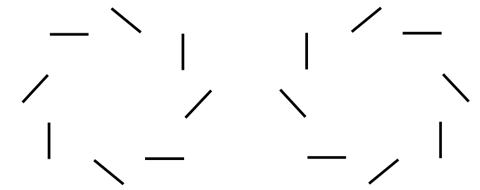
Diagram of B-mode polarization with a clockwise and counterclockwise spiral.
BICEP2's Measurements
On March 17, 2014, astronomers stated that they had detected a particular polarization pattern in the cosmic microwave background 380,000 years after the Big Bang (that is basically in our universes infant years).
They did this with an array of 512 superconducting microwave detectors pointed toward a part of the sky that has very few emissions of the radiation they were looking for.
BICEP2 has the ability to measure the cosmic microwave background with great precision (to 0.0000001˚ K), which allows the research team to rule out the other B-mode polarizations due to gravitational lensing. And their observations of the effects were much larger than they expected (20 times larger).
The scientists compared their data with data from an earlier experiment dubbed BICEP1, and with a new polarization experiment with the Keck array (also at the South Pole). All three were seeing the same characteristics. These multiple observations from different devices give great credence to the results.
Lasting Impact
These results support inflation theory, which has done a great job of making accurate predictions about our universe, but inflation requires more evidence based on empirical measurements.
The results are still in the process of being reviewed by many scientists, but if they hold up to scientific scrutiny, it will put the exponential expansion of our universe at 10-37 of a second from the big bang, with energies at about 1016 GeVs (a trillion times more than the highest energy scientists can achieve at particle accelerators).
At these energies, the weak, electromagnetic, and strong forces become indistinguishable, which is part of the grand unification theory.
Because this also happens on the realm of the small, where quantum mechanics resides, and because inflation theory begins with quantum fluctuations, it provides the first ever possible empirical evidence for quantum gravity, (and gravitons).
One of the difficulties of general relativity has been to reconcile it with quantum mechanics. If it is to correspond to the currently accepted theories of the very small, then there should be a corresponding particle that that transmits the force of gravitation.
For example, electromagnetic forces have a corresponding particle, the photon; the weak force has W and Z bosons that mediate it, the strong force has gluons that mediate the strong interaction. No one has yet to obtain accepted empirical evidence for the predicted graviton particle that is believed to mediate gravitational interactions.
Scientists will continue mapping out the cosmic microwave background, looking for the signature polarization to find further evidence for gravitational waves, and for understanding of how our universe began. The Keck array at the South Pole will continue taking data for two more years.
The Planck telescope might take a full sky survey of the polarization. And the land based gravitational observatories will continue to look for direct evidence of gravitational waves.
References and Resources
1. Gravitational Waves, Wikipediahttp://en.wikipedia.org/wiki/Gravitational_wave
2. LIGO Media Information
http://www.ligo.caltech.edu/LIGO_web/PR/scripts/facts.html
3. VIRGO
http://www.ego-gw.it/public/virgo/virgo.aspx
4. Cowen, R., How Astronomers Saw Gravitational Waves from the Big Bang Nature, News: Q&A , 17 March 2014
5. Cowen, R., Telescope captures view of gravitational waves, Nautre, News in Focus 507 (2014)
6. Cowen, R., Gravitational-Wave Finding Causes “Spring Cleaning” in Physics, Scientific American, 24 March 2014
http://www.scientificamerican.com/article/gravitational-wave-finding-causes-spring-cleaning-in-physics/
7. Carroll, S. Gravitational Waves in the Cosmic Microwave Background, Sean Carroll’s blog, 16 March 2014
http://www.preposterousuniverse.com/blog/2014/03/16/gravitational-waves-in-the-cosmic-microwave-background/
8. Cho, A. and Bhattacharjee, Y., First Wrinkles in Spacetime Confirm Cosmic Inflation, Science 343 21 March 2014
—H.M. Doss














